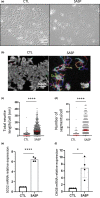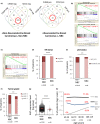NF-κB-dependent secretome of senescent cells can trigger neuroendocrine transdifferentiation of breast cancer cells
- PMID: 35653631
- PMCID: PMC9282844
- DOI: 10.1111/acel.13632
NF-κB-dependent secretome of senescent cells can trigger neuroendocrine transdifferentiation of breast cancer cells
Abstract
Cellular senescence is characterized by a stable proliferation arrest in response to stresses and the acquisition of a senescence-associated secretory phenotype, called SASP, composed of numerous factors including pro-inflammatory molecules, proteases, and growth factors. The SASP affects the environment of senescent cells, especially during aging, by inducing and modulating various phenotypes such as paracrine senescence, immune cell activity, and extracellular matrix deposition and organization, which critically impact various pathophysiological situations, including fibrosis and cancer. Here, we uncover a novel paracrine effect of the SASP: the neuroendocrine transdifferentiation (NED) of some epithelial cancer cells, evidenced both in the breast and prostate. Mechanistically, this effect is mediated by NF-κB-dependent SASP factors, and leads to an increase in intracellular Ca2+ levels. Consistently, buffering Ca2+ by overexpressing the CALB1 buffering protein partly reverts SASP-induced NED, suggesting that the SASP promotes NED through a SASP-induced Ca2+ signaling. Human breast cancer dataset analyses support that NED occurs mainly in p53 WT tumors and in older patients, in line with a role of senescent cells and its secretome, as they are increasing during aging. In conclusion, our work, uncovering SASP-induced NED in some cancer cells, paves the way for future studies aiming at better understanding the functional link between senescent cell accumulation during aging, NED and clinical patient outcome.
Keywords: aging; breast cancer; cellular senescence; neuroendocrine transdifferentiation; senescence-associated secretory phenotype.
© 2022 The Authors. Aging Cell published by Anatomical Society and John Wiley & Sons Ltd.
Conflict of interest statement
The authors have declared that no conflict of interest exists.
Figures




References
-
- Acosta, J. C. , Banito, A. , Wuestefeld, T. , Georgilis, A. , Janich, P. , Morton, J. P. , Athineos, D. , Kang, T. W. , Lasitschka, F. , Andrulis, M. , Pascual, G. , Morris, K. J. , Khan, S. , Jin, H. , Dharmalingam, G. , Snijders, A. P. , Carroll, T. , Capper, D. , Pritchard, C. , … Gil, J. (2013). A complex secretory program orchestrated by the inflammasome controls paracrine senescence. Nature Cell Biology, 15, 978–990. - PMC - PubMed
-
- Acosta, J. C. , O'Loghlen, A. , Banito, A. , Guijarro, M. V. , Augert, A. , Raguz, S. , Fumagalli, M. , da Costa, M. , Brown, C. , Popov, N. , Takatsu, Y. , Melamed, J. , d'Adda di Fagagna, F. , Bernard, D. , Hernando, E. , & Gil, J. (2008). Chemokine signaling via the CXCR2 receptor reinforces senescence. Cell, 133, 1006–1018. - PubMed
-
- Al‐Mawla, R. , Ducrozet, M. , Tessier, N. , Paita, L. , Pillot, B. , Guoriou, Y. , Villedieu, C. , Harhous, Z. , Paccalet, A. , Da Silva, C. C. , Ovize, M. , Bidaux, G. , Ducreux, S. , & Van Coppenolle, F. (2020). Acute induction of Translocon‐mediated Ca2+ leak protects cardiomyocytes against ischemia/reperfusion injury. Cell, 9, 1319. - PMC - PubMed
-
- Bosson, C. , Rendu, J. , Pelletier, L. , Abriat, A. , Chatagnon, A. , Brocard, J. , Brocard, J. , Figarella‐Branger, D. , Ducreux, S. , van Coppenolle, F. , Sagui, E. , Marty, I. , Roux‐Buisson, N. , & Faure, J. (2020). Variations in the TRPV1 gene are associated to exertional heat stroke. Journal of Science and Medicine in Sport, 23, 1021–1027. - PubMed
-
- Campisi, J. , & d'Adda di Fagagna, F. (2007). Cellular senescence: When bad things happen to good cells. Nature Reviews Molecular Cell Biology, 8, 729–740. - PubMed
Publication types
MeSH terms
Substances
LinkOut - more resources
Full Text Sources
Medical
Research Materials
Miscellaneous

